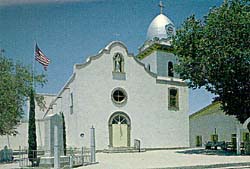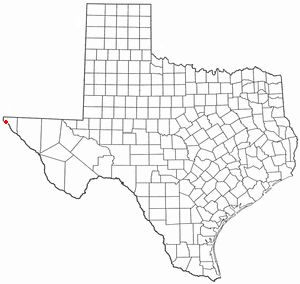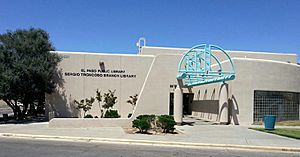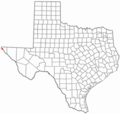Ysleta, El Paso, Texas facts for kids
Quick facts for kids
Ysleta
|
|
|---|---|

Mission de Corpus Christi de la Ysleta
|
|

Location in the state of Texas
|
|
| Country | United States |
| State | Texas |
| County | El Paso County |
| Ysleta del Sur | 1682 |
| Area | |
| • Total | 0.07 sq mi (.17 km2) |
| Elevation | 3,687 ft (1,124 m) |
| Time zone | UTC-6 (MDT) |
| • Summer (DST) | UTC-6 (CDT) |
| Website | Ysleta Mission |
| Average Annual Precipitation (inches)= 8.20 | |
Ysleta is a community located in El Paso, Texas, in the United States. It was founded between October 9 and October 12, 1680. At that time, Spanish explorers (called conquistadors), religious leaders (Franciscan clerics), and Tigua Native Americans found safety there. They settled along the southern bank of the Rio Grande river.
These groups were escaping the Pueblo Revolt, a major uprising in New Mexico. Ysleta holds a special place in history. It is the oldest European settlement in what is now the U.S. state of Texas.
Contents
History of Ysleta
How Ysleta Was Settled
In 1680, Antonio de Otermín, the Spanish Governor, put Fray Francisco de Ayeta in charge of a refugee camp. This camp was for people escaping a rebellion led by Popé. The camp and its mission church were about three miles south of the Rio Grande. The river often flooded and left behind a lot of mud.
Moving and Rebuilding Ysleta
The settlement and its mission moved several times over the next few centuries. In 1691, the first mission was replaced with a building made of adobe bricks. However, a flood in 1740 destroyed this mission. It was rebuilt four years later on higher ground.
The Tigua people of Ysleta were very loyal to their Christian faith. The Spanish wanted to keep the settlement strong and thriving. Between 1829 and 1831, the Rio Grande river shifted much further south. In 1836, the new country of Texas claimed this new river channel as its border.
In 1848, after the Treaty of Guadalupe Hidalgo was signed, Ysleta became part of the United States. The mission was also a stop on the Butterfield Overland Mail route from 1858 to 1861. This was a famous stagecoach trail.
Ysleta Becomes a City
The nearby town of San Elizario was a center of Hispanic culture. This was especially true after the Civil War, when more English-speaking people moved into the area. In 1873, Ysleta tried to become the county seat, which is the main town of a county.
However, the elections were unclear until 1878, after a conflict called the San Elizario Salt War. Because of this, the people of Ysleta officially became a Texas city in 1880. There were arguments about whether the taxes were worth being a city. Also, the growing community of El Paso did not want an "Indian" city to be the county seat.
The railroad did not come to Ysleta. In a very disputed election in 1883, the county seat moved to El Paso. The town government of Ysleta then ended in 1895.
Challenges and Changes
In 1907, a chemical fire damaged the Ysleta Mission. In 1916, the Rio Grande was dammed, and the area was heavily irrigated. This caused the water underground to rise, bringing salt to the surface. The land then became suitable only for crops that could grow in salty soil, like cotton.
Ysleta Joins El Paso
In 1955, El Paso officially took over Ysleta. This happened even though Ysleta residents voted against it. Ysleta was allowed to keep its own school district, the Ysleta Independent School District. This district serves areas from the lower Valley to parts of Northeast El Paso. This decision required an appeal to the Supreme Court.
Revival of the Tigua People
In the 1960s, a lawyer named Tom Diamond filed a lawsuit to help the Tiwa people. They were known as the Tigua tribe in Spanish. The state of Texas was at first unwilling to recognize any Native American tribes. But in 1967, the Tiguas were legally formed as the Ysleta Del Sur Pueblo. The next year, the United States Congress also officially recognized the tribe.
Education in Ysleta
Students in Ysleta are served by the Ysleta Independent School District. Ysleta High School is the main high school for the area.
The El Paso Public Library also operates the Sergio Troncoso Branch in Ysleta.
Images for kids




